What to Avoid in Cat Food – Simple Guide for Safe Feeding
If you’ve ever stared at a bag of cat food wondering what’s really inside, you’re not alone. Cats are picky, and they rely on us to pick food that supports their tiny bodies. The good news? You can spot the bad stuff in seconds once you know what to look for.
Dangerous Ingredients to Watch Out For
Artificial colors and flavors. These bright blues and reds may make the kibble look appealing, but they offer no nutritional value. Some cats even develop skin irritations or digestive upset from the chemicals.
By‑products and meat meals. Words like “chicken meal” or “meat by‑product” often hide low‑quality parts of the animal. They’re cheap, but they lack the essential proteins cats need for strong muscles and a shiny coat.
Added sugars and corn syrup. Cats don’t need sugar – they’re obligate carnivores. Sweeteners can lead to weight gain, diabetes, and a cranky kitty who isn’t interested in his food.
Excessive fillers such as corn, wheat, or soy. These plant‑based carbs are hard for cats to digest and can trigger food sensitivities. Look for grain‑free options if your cat shows signs of itching or tummy trouble.
Preservatives like BHA, BHT, and ethoxyquin. While they keep the food fresh, they’ve been linked to liver issues in pets. Natural alternatives like mixed tocopherols are a safer bet.
Questionable Practices & Marketing Tricks
“Grain‑free” hype. Not all grain‑free foods are better. Some replace grains with more fillers, so always read the ingredient list, not just the front label.
“Made in the USA” badge. This doesn’t guarantee quality. Factories in any country can cut corners. Check if the brand follows strict safety audits and provides a transparent sourcing list.
“Limited ingredient” claims. A short list sounds good, but if the few ingredients are low‑quality, the food still isn’t great. Look for limited‑ingredient diets that use real animal protein as the first item.
“High protein” boasting. Many brands add plant protein to pad the numbers. True high‑protein cat food uses real meat as the top ingredient, not pea protein or soy.
Finally, always trust your cat’s reaction. If they’re finicky, it could be a sign the food contains something they dislike or can’t tolerate. A quick switch to a cleaner, simpler formula often makes a dramatic difference in energy, coat shine, and bathroom habits.
Bottom line: steer clear of bright colors, vague meat‑by‑products, sugary fillers, and harsh preservatives. Choose foods where real meat is first, and the ingredient list is short enough to read in a minute. Your cat will thank you with more purrs, fewer vet trips, and a healthier, happier life.
Posted By Bryndle Redding On 5 Aug 2025 Comments (0)
Hidden Dangers in Dry Cat Food: What Ingredients to Avoid for Your Cat's Health
Learn what harmful ingredients lurk in dry cat food. Find out which additives and fillers to watch for and how to choose healthier options for your cat.
READ MORE